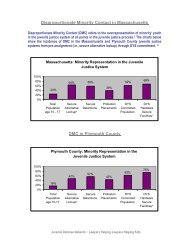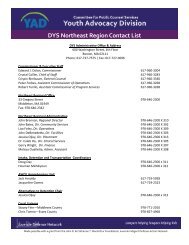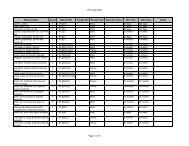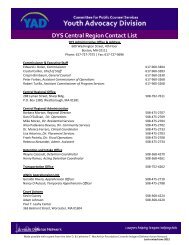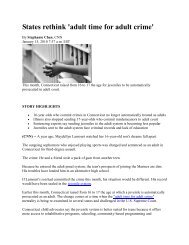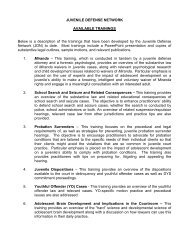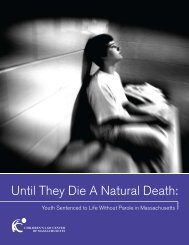health and counseling edition - the Youth Advocacy Division
health and counseling edition - the Youth Advocacy Division
health and counseling edition - the Youth Advocacy Division
Create successful ePaper yourself
Turn your PDF publications into a flip-book with our unique Google optimized e-Paper software.
FALL 2008<br />
COMMUNITY NOTEBOOK: HEALTH AND COUNSELING EDITION<br />
ADDRESSING THE UNIQUE CHARACTERISTICS OF ADOLESCENT ALCOHOL AND<br />
SUBSTANCE ABUSE: THE BUREAU OF SUBSTANCE ABUSE SERVICES<br />
Margaret Giovannetti<br />
Adolescence is a difficult time, during<br />
which youth transition toward <strong>the</strong> expectations<br />
<strong>and</strong> experiences of adulthood. In order to<br />
achieve <strong>health</strong>y maturity, youth must be granted<br />
room to experience life <strong>and</strong> experiment with how<br />
<strong>the</strong>y fit in among <strong>the</strong>ir family, peers, <strong>and</strong> society.<br />
Often, young adults are afforded certain<br />
freedoms before <strong>the</strong>y underst<strong>and</strong> <strong>the</strong><br />
consequences of <strong>the</strong>ir choices <strong>and</strong> actions. This<br />
potential pitfall can be exacerbated if young<br />
people lack caring adults or mentors in <strong>the</strong>ir lives<br />
who can model positive behavior. Without a<br />
trusted <strong>and</strong> responsible adult to be an important<br />
role model <strong>and</strong> sounding board, many youth<br />
struggle with decision-making <strong>and</strong> have no one<br />
with whom to discuss important life choices.<br />
When youth begin making choices<br />
concerning alcohol, drugs, <strong>and</strong> o<strong>the</strong>r substances,<br />
positive role models <strong>and</strong> clear decision-making is<br />
imperative. For those youth who lack adequate<br />
supports <strong>and</strong> are at-risk to develop substance<br />
abuse issues, <strong>the</strong>re is danger for long-term,<br />
sustained problems. Alcohol <strong>and</strong> substance<br />
abuse is obviously a major detriment to young<br />
people’s ability to achieve positive life outcomes.<br />
Despite a bombardment of anti-drug <strong>and</strong> alcohol<br />
education that youth receive from teachers,<br />
doctors, television, <strong>and</strong> in-school <strong>and</strong> afterschool<br />
Margaret Giovannetti is <strong>the</strong> Massachusetts<br />
Department of Public Health’s Bureau of<br />
Substance Abuse Services Adolescent<br />
Service Coordinator.<br />
programs, substance abuse remains a widespread<br />
problem <strong>and</strong> can be a principal factor in <strong>the</strong><br />
interruption of physical <strong>and</strong> cognitive<br />
development. Under <strong>the</strong> influence of drugs <strong>and</strong><br />
alcohol, youth can find <strong>the</strong>mselves in<br />
compromising situations which may lead to courtinvolvement<br />
<strong>and</strong>/or poor <strong>health</strong>.<br />
Adolescent drinking <strong>and</strong> drug use is often<br />
associated with sexual activity, unwanted sexual<br />
activity, suicide attempts, weapons possession,<br />
<strong>and</strong> physical fights. A 2005 survey of<br />
Massachusetts students in grades 9-12 showed<br />
that in <strong>the</strong> 30 days prior to <strong>the</strong> survey, nearly half<br />
of students (48%) drank alcohol, 27% had five or<br />
more drinks in a row (<strong>the</strong> definition of binge<br />
drinking), <strong>and</strong> 28% rode in a car driven by<br />
someone who had been drinking. One-third of<br />
students had bought, been offered, or been given<br />
an illegal drug on school property within <strong>the</strong><br />
previous year. Between 2003 <strong>and</strong> 2005, <strong>the</strong>re was<br />
no meaningful reduction in <strong>the</strong> use of drugs.<br />
The effects of alcohol <strong>and</strong> substance<br />
abuse on youth are far reaching. Alcohol use is<br />
related to lower levels of academic achievement.<br />
Seventy-two percent of youth in Massachusetts<br />
correctional services have been diagnosed with a<br />
substance abuse disorder. Of those youth in<br />
Massachusetts who meet <strong>the</strong> criteria for a mental<br />
<strong>health</strong> disorder, 49% regularly abuse substances.<br />
In all likelihood, your client has or is at risk for<br />
developing alcohol or substance abuse issues. As<br />
professionals dedicated to helping youth develop<br />
into <strong>health</strong>y adults, <strong>the</strong>re are steps to take to help<br />
youth avoid <strong>the</strong> trap of alcohol <strong>and</strong> substance<br />
abuse.<br />
SUBSTANCE ABUSE AMONG<br />
MASSACHUSETTS TEENS<br />
A 2005 survey of students in grades<br />
9-12 showed that in <strong>the</strong> last 30 days¹:<br />
Nearly half (48%) drank alcohol<br />
27% had five or more drinks in a row (<strong>the</strong><br />
definition of binge drinking)<br />
28% rode in a car driven by someone who<br />
had been drinking<br />
30% had bought or been offered or given<br />
an illegal drug on school property in <strong>the</strong> last<br />
year<br />
There was no meaningful reduction in<br />
students’ drinking or use of marijuana,<br />
heroin, cocaine, crack or freebase between<br />
2004 <strong>and</strong> 2005<br />
HARMFUL SIDE EFFECTS OF<br />
TEEN SUBSTANCE ABUSE<br />
Alcohol use is related to lower levels of<br />
academic achievement<br />
Nearly three quarters (72%) of youth in<br />
Massachusetts Correctional Services have<br />
substance use disorders<br />
Nearly half (49%) of youth with mental<br />
<strong>health</strong> needs in <strong>the</strong> state regularly use<br />
substances<br />
Adolescent drinking is associated with:<br />
current drug use, recent sex, unwanted sex<br />
contact, suicide attempts, carrying<br />
weapons, <strong>and</strong> physical fights<br />
¹2005 <strong>Youth</strong> Risk Behavior Survey,<br />
http://www.doe.mass.edu/cnp/hprograms/yrbs/05/default.html<br />
10<br />
www.youthadvocacyproject.org





